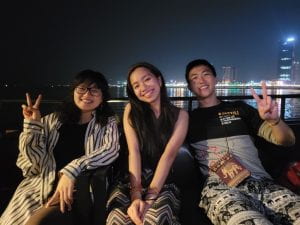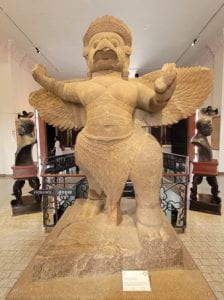 On our last full day in Phnom Penh, we started off with a guided tour of the National Museum of Cambodia, which boasts works from several eras of Cambodian history: Pre-Angkorian, Angkorian, and post-Angkorian. When we first walked in, we were greeted by a statue of Garuda, found originally at the large pyramid Prasat Thom in Koh Ker and was put on display in the museum after it was repatriated. It was nice to see an extended collection of works created throughout Cambodian history, building upon our visit to the Angkor National Museum in Siem Reap. There are not many pictures from this visit since they did not allow photography within the museum.
On our last full day in Phnom Penh, we started off with a guided tour of the National Museum of Cambodia, which boasts works from several eras of Cambodian history: Pre-Angkorian, Angkorian, and post-Angkorian. When we first walked in, we were greeted by a statue of Garuda, found originally at the large pyramid Prasat Thom in Koh Ker and was put on display in the museum after it was repatriated. It was nice to see an extended collection of works created throughout Cambodian history, building upon our visit to the Angkor National Museum in Siem Reap. There are not many pictures from this visit since they did not allow photography within the museum.
After lunch we had a talk with Bradley Gordon, an international lawyer working with Cambodia’s commission for repatriation, or return, of stolen artifacts to Cambodia. He introduced us to a few people on his team, all of which are women supposedly because they work better together, are more detail-oriented, and are trusted by interviewees to a greater degree. Kanya started off by talking about their team’s research process in figuring out when and how a statue was stolen and by whom. Before official interviews begin, they spend time with villagers living in the areas surrounding looted sites to gain repertoire. When the time is right, the team interviews the villagers about anything and everything they may remember around the time the statue was stolen. This information is then given to other researchers and government officials to piece together with other intel they may have gathered on different heritage pieces.
Next, Rahi, a person of Cham descent, talked to us about her work to recover Cham artifacts–dating back to the 7th and 8th century–from Australia. There are many difficulties she faces in the work she is doing, including having to traverse deep into rural areas to conduct interviews and having limited research sources because the history she is looking to uncover has not been recorded anywhere. Additionally, as a predominantly Muslim population, many of the Cham people she speaks to don’t have an interest in recovering the Buddhist statues that were stolen from their heritage in the past. Her team also faces opposition from Australia, who had paid approximately $1.5 million for these statues in the first place.
The last team member we talked to was Satra, who was the first villager in Koh Ker to go to college! She is currently working on Gordon’s team to recover stolen statues that originated in Koh Ker, utilizing her village connections to glean as much helpful information as possible.
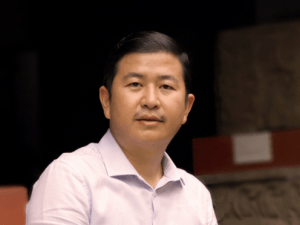
Chhay Visoth, director of the National Museum of Cambodia, stopped by during our talk to introduce himself and to welcome us to the museum. He spoke about welcoming loan agreements with other museums and private collections since they are a way to formally introduce Cambodian culture to other countries. At the same time, the museum is currently still incorporating artifacts repatriated from unauthorized collectors, a big one being the United States.
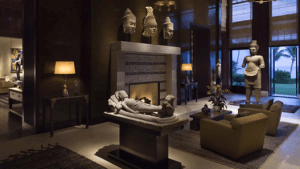
Some notable points from this talk were that museums are not the main worry when it comes to repatriating works–it’s actually private collectors. Private collections are just that, private, and there is no way of knowing for sure who what what without careful investigation. Gordon also mentioned they are mainly relying on the moral stance that returning pieces of Cambodian heritage is the right thing to do. The legal stance, on the other hand, is a shaky one mainly because it’s difficult to enforce international law on every country and there may be legal loopholes used to justify keeping the statues in the first place. One of the most effective ways of repatriation is through the use of media to garner public (international) support, and Gordon’s team is currently working with Cambodia’s government to do so.
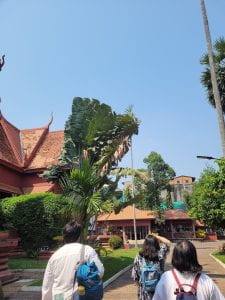 Following our talk with Gordon, he gave us a tour of the Stone Lab adjacent to the museum where we got to see more members of his team working on restoring different works. One statue was a never-seen-before depiction of Shiva and his son, Skanda, facing each other having a teaching moment (where Skanda is teaching Shiva of course). This statue will be officially revealed to the public in March. An issue that comes up in the lab is the discovery of counterfeit statues, but Gordon’s team goes through great lengths to ensure that the statue presented to the public is legitimate and worthy of the elaborate ceremonies that are organized when a statue is returned to Cambodia. When it comes to getting the statue back to its home country, Cambodia has to pay a shipping cost upwards of a whopping $50,000.
Following our talk with Gordon, he gave us a tour of the Stone Lab adjacent to the museum where we got to see more members of his team working on restoring different works. One statue was a never-seen-before depiction of Shiva and his son, Skanda, facing each other having a teaching moment (where Skanda is teaching Shiva of course). This statue will be officially revealed to the public in March. An issue that comes up in the lab is the discovery of counterfeit statues, but Gordon’s team goes through great lengths to ensure that the statue presented to the public is legitimate and worthy of the elaborate ceremonies that are organized when a statue is returned to Cambodia. When it comes to getting the statue back to its home country, Cambodia has to pay a shipping cost upwards of a whopping $50,000.
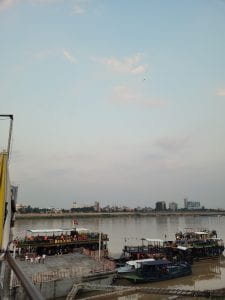 Our last activity of the day was a boat tour of Tonlé Sap, a lake adjacently connected to the Mekong River system. It is also the location of where the Cham had attacked the Khmer Empire from in 1177, leading to their conquering of Angkor for about 4 years.
Our last activity of the day was a boat tour of Tonlé Sap, a lake adjacently connected to the Mekong River system. It is also the location of where the Cham had attacked the Khmer Empire from in 1177, leading to their conquering of Angkor for about 4 years.
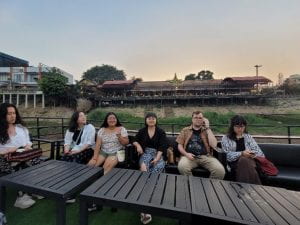 Although we were stagnant in the boat for the first hour waiting for our food orders to come in from the mainland, the nice and chilly air during the boat ride was worth it.
Although we were stagnant in the boat for the first hour waiting for our food orders to come in from the mainland, the nice and chilly air during the boat ride was worth it.
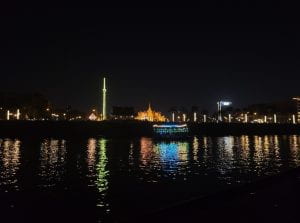 That’s a wrap of our last full day in Phnom Penh! We are sad to say goodbye to Cambodia’s bustling capital city–there’s lots left to explore in the case we return in the future!
That’s a wrap of our last full day in Phnom Penh! We are sad to say goodbye to Cambodia’s bustling capital city–there’s lots left to explore in the case we return in the future! 